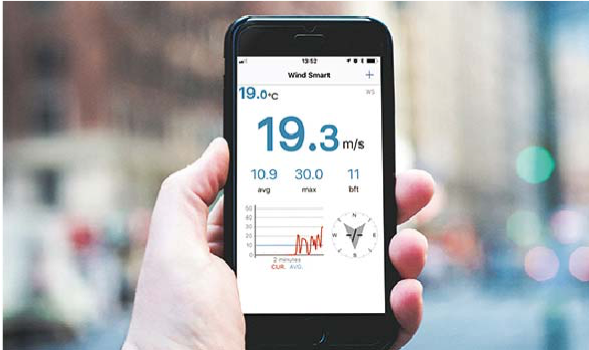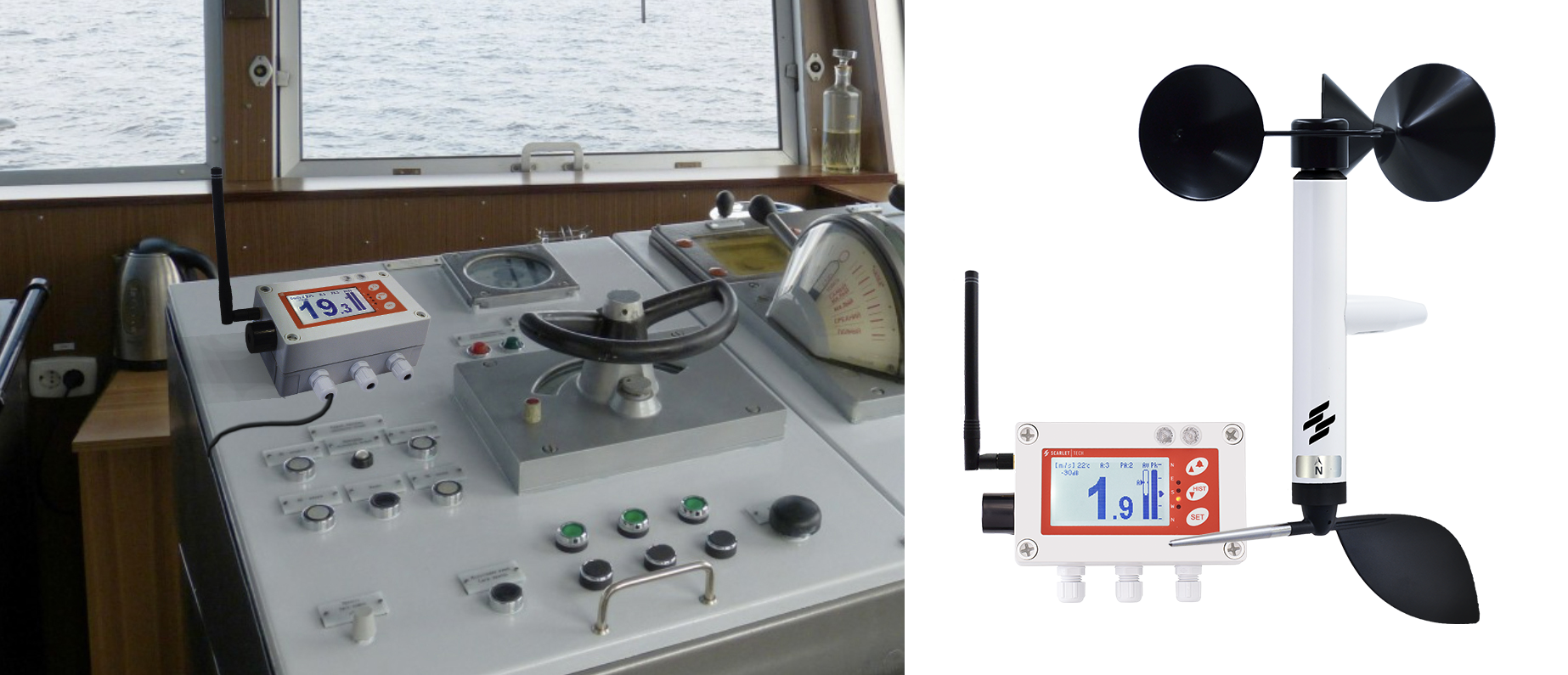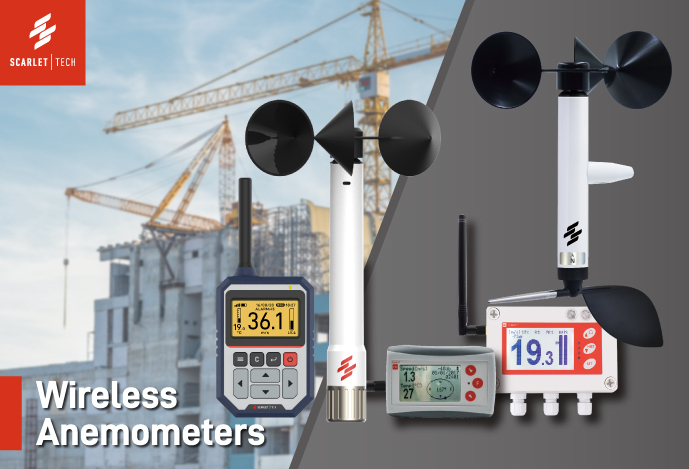Know How –
How to choose the perfect anemometer for construction site safety by crane wind speed limits?
What is an Anemometer? How does it work?
There are many different types of anemometers in the market with different functionalities. Before choosing any of the anemometers, you have to get complete knowledge about it in order to meet your demands. Here is a glimpse of information about different types of anemometers.
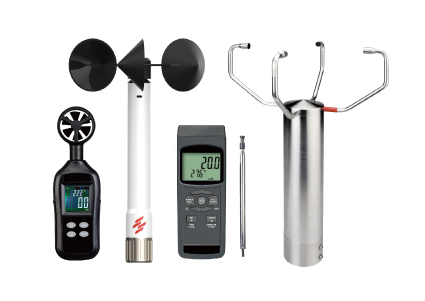
Different types of Anemometer sensors:
| Type | Features | Pros | Cons | Where to apply |
|---|---|---|---|---|
Cup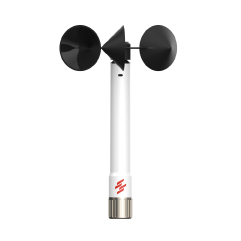 | • Often consist of 3 or 4 wind cups • Convert the wind cups rotation into the velocity of the wind | • Cups are highly durable and reliable • Does not need to be pointed to the wind direction | • The starting velocity is often high • Vulnerable to icing condition | • Towers, weather stations • Construction sites • Research and meteorology institutions worldwide • Aerodrome and marine and shipping boat |
Vane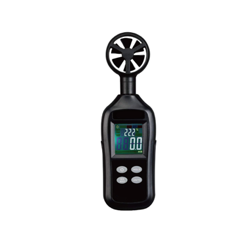 | • Sensors are designed to look like a windmill or turbine • Can only spin in the horizontal axis | • Suitable for harsh environments • Durable • Designed for higher wind speeds | • Need to be pointed towards the wind source for accuracy • Smaller vanes often need higher starting speed | • Great for mining measurement of the speed of methane releases from in gob holes. • Engine maintenance and inspection • Roof and garage of suburban houses |
Hot Wire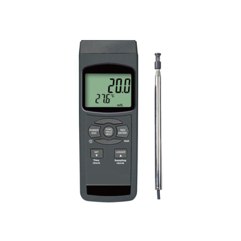 | • The wire is electrically heated to a certain temperature • Wind velocity is calculated through the heat transfer | • Lasts longer • Consist low starting threshold • Provides error-free reading | • Not effective in areas with rapid temperature fluctuations • Not suitable for dirty environment | • Research tool in fluid mechanics • Scientific studies of boundary layer flows in wind tunnels • Laboratory settings |
Sonic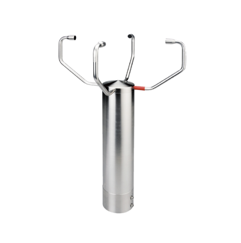 | • Use the ultrasonic sound waves to measure the wind velocity • Wind speed is measured in terms of the time of flight for the sonic pulses between the various transducers | • Weather resistant and suitable for extreme weathers • No rotating parts that could easily wear out • Not affected by icing | • More expensive • Animals may sit on the probes resulting in false reading | • Detailed turbulence measurements • Research instrument • Eddy covariance requiring high speed and accurate measurement |
Many people prefer handheld anemometers because of their convenience and portability.
Cup anemometers are the simplest type of anemometers. The anemometers consist of several spinning cups mounted on a pole. The three cup anemometers are the most common seen. As the wind grows stronger, the cup spins faster and the anemometer transfer the speed of airflow and displays it as a digital readout. Cup anemometers are commonly used by professional weather stations and Research institutions. They sometimes come as part of a larger precision weather instruments. Anemometers also come in different form factors: some are designed to be mounted on the outside of buildings; others work well on top of a car, or for handheld portable use.
Another type of anemometers are vane anemometers. They are also known as propeller or windmill anemometers. The anemometers are similar to the cup anemometers, but they use an array of wind blades instead of spinning cups. Vane anemometers must be facing to the direction where wind is blowing. They often use a wind vane opposite the propeller to shift in the direction of the wind. A vane anemometer is used for measuring the velocity and volumetric flow rate on air grills in residential buildings and utility. Possible in combination with a measuring cone when the flow is not laminar. The speed of the rotating vane of the anemometer is converted into electric power, which is then transferred into the air speed.
Like cup anemometers, vane anemometers or propeller anemometers automatically count the number of revolutions per second to calculate wind speed and display digitally. They work well in mines to measure the speed of methane release.
The Hot Wire Anemometer is a device used for measuring the velocity and direction of the fluid. This can be done by measuring the heat loss of the wire that is placed in the fluid stream. The wire is heated by electrical current. When placed in the stream of the fluid, the heat is transferred from wire to fluid, hence the temperature of the wine reduces. The resistance of wire measures the flow rate of the fluid. It is best for accurately measuring airflow at low velocities (eg., under 2000 ft/min). Some models are designed to measure velocities as high as 15,000 ft/min but still have very accurate measuring capability down to much lower speeds.
Hotwire anemometers measure both wind speed and pressure. The device is a long rod and at the tip is a hot wire or hot bead. It measures the airflow through building ducts. You can find this type of anemometer in the heating, ventilating and air-conditioning businesses. Also, are often used as research tools in fluid mechanics.
Ultrasonic anemometers send sonic pulses across a path to the sensor on the opposite side. As the wind moves more quickly, the pulses are disrupted. It employs the ultrasonic sound waves to calculate the wind velocity. A measurement of this disruption provides accurate wind data. An ultrasonic anemometer has no moving parts and can detect even small changes in the wind. The device typically has four sensors arranged in a square pattern. Some units come with built-in heaters. Moreover, this device is weather resistant and suitable for working in severe weather condition. As the device is internally heated, icing can have no effect on it. This type is quite popular in aircraft and scientific wind turbines. Since they do not have many moving parts, they can also be used in automated weather stations. Ultrasonic anemometers have many strengths, however, it is very rare, which making it even more expensive to repair comparing to other types of anemometers.
Why do you need an anemometer at construction sites?
Keeping an eye on weather conditions is a pretty crucial task on most work sites. Potential injuries from worker slips or falls, along with the risks of damage caused by improperly secured loads or machinery, are among the most pressing health and safety concerns on inclement weather conditions, particularly strong or changeable winds, will typically intensify these types of risks.
Once on site, the ability to monitor fast-changing weather conditions is extremely important. Wind is quite tricky. it’s extremely changeable, unlikely to be consistent across all areas of a site, and some of the safety concerns aren’t always apparent.
Local wind behavior like wind tunnel effects, also constitute an important source of risks and may surprise operators of mobile elevating work platforms or other lifting apparatus working between two or more buildings.
Ignorance of the wind speed may delay the taking of decisions that can be vital and have grave consequences on the personnel, equipment and environment of a site. The load movements on a construction site may become uncontrollable under strong wind conditions. Sometimes, the strength of the wind may even overturn the machines.
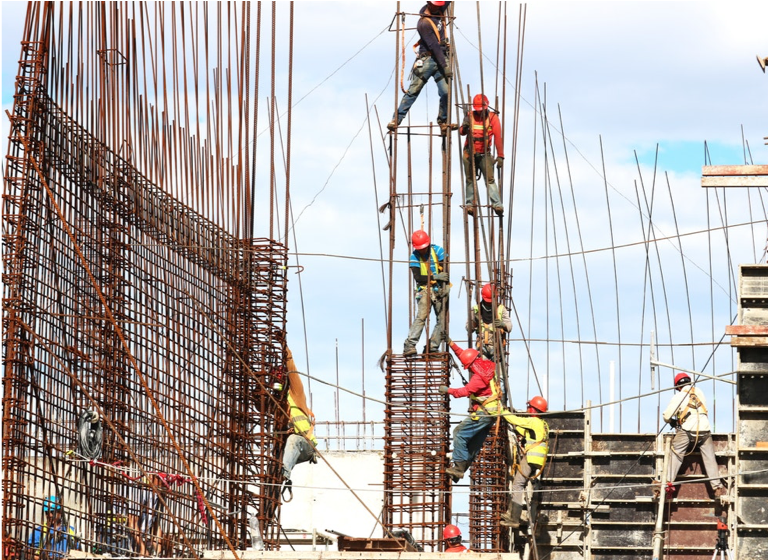
Wind speed tends to increase with altitude. As the safety of the workers is the absolutely top priority, special attention must be paid to anyone operating at height, where wind speeds can be considerably higher than on the ground due to their increased exposure. Cranes and towers are at particular risk, as are roofers and anyone working on scaffolding. The best solution for monitoring wind speeds at various locations across a site is using anemometers, which allows you to measure both prevailing speeds and sudden gusts via either mechanical or digital means. You’ll also be able to keep an eye on any shifts in wind direction. It’s particularly important in situations where loads and equipment will be raised significantly above the ground or building, which is especially relevant when planning tasks involving crane operation and heavy lifting. Attaching an anemometer to the boom point is a sensible way to monitor the different wind speeds at operating altitudes for cranes.
Wind speed meters constitute a preventive measure against risks associated with the strength of the wind. They measure its speed with precision and supply the site personnel with the necessary information to make the proper decisions.
If inclement weather does force works to stop temporarily, anemometers are also extremely useful tools to have on hand as they allow the team to show precisely how the conditions impacted on the progress of the job.
Other industries that need anemometers
Beside construction, anemometers are actually used in a wide variety of industries ranging from heavy-machinery and transportation such as crane, airports, helipad to marine, agriculture, and aquaculture.
In addition, anemometers are also widely used in film production, outdoor sports, and leisure industry such as amusement park, sky diving, hot air ballon, etc.
Things to consider when buying anemometers
There really isn’t the best type of anemometer. Each type of wind speed monitors works slightly different and may be better for some uses than others. For instance, if you’re looking for a portable handheld wind speed monitor, you might want to consider a vane anemometer or a hot wire anemometer because a cup anemometer might be a bit too bulky to carry.
Some anemometers are easy to take with you wherever you go, and others come as part of wireless weather stations that you can place in your backyard and read off an indoor monitor. Additionally, some handheld anemometers are compact for portable use and others have long cables for mounting purposes. Some anemometers are better for HVAC installation or repair uses and others like hot wire air velocity meters are great for measuring the air flow that may be coming in from a drafty door or window. Many anemometers today connect to an app on your smartphone or tablet as well.
1. Quality
There are many different types of anemometer available but we cannot buy everything on the market. You have to choose the type of anemometer based on your needs and conditions. For instance, can it resist high or low temperature? How long is the warranty? Can this brand be trusted? For the best performance and to get a longer life, quality is very important to buy any product.
2. Accuracy
Accuracy is very important for this device or else it will create a lot of issues. Before purchasing the products you have to read the reviews. Nothing is more important than accuracy in anemometer so it is better to double check. We are able to get information about working principles on the internet is very helpful for us. You can also purchase a sample before bulk purchase to check if the data is accurate and make sure it meets your needs.
3. Price
While buying, first you have to decide what kind of devices will be the most suitable for you. Handheld anemometers are easy to carry anywhere and also give you the result instantly. Depends on the features and comfort, the cost will vary. The average of low price anemometers is 199USD, range medium priced is around 680-760USD and higher priced are 1200-1800USD. You can purchase your anemometer based on your needs and take price into consideration. Choose the most suitable device that is best for your budget and with great quality as well.
Scarlet E10/11 Ex-Proof
Scarlet E10/11 is the World’s first ATEX approved intrinsically safe wireless anemometer in Zone 1 & Zone 2 hazardous environments. It consists of a ex-proof wind speed sensor and a receiver. The sensor measures wind speed and transmits data to the receiver. It has a 3-year long battery life and low-power battery consumption which significantly reduces maintenance time and cost.
Scarlet E10/11 is ATEX Certified EX II 2 G EX ib IIB T4 and comply to OSHA standards. It is designed to hold up in tough and extreme working environment, not only explosion-proof but it is also water proof. E10/E11 has stable wireless transmission distance up to 400 meters/ 1,300 meters (XB model). Moreover, it has three different active warning & alarm set points which enable users to customize their own alarm system.
What’s more interesting is that, apart from the receiver, you can also connect it with a smartphone App to monitor the real-time wind data on your phone. Free download the App on IoS and Android.
Scarlet WL-410
Scarlet WL-410/XB Wireless Wind Alarm System consists of a wind speed sensor and a receiver. The sensor measures wind speed and transmits data to the receiver. The 3.5-inch LCD display of receiver shows readings on the main page and the history graphs are shown on different pages. Based on the preset values, the receiver can trigger local alarms such as LED lights and buzzer, or trigger external indication via 3 built-in relays when measured wind speeds exceeding the thresholds. The latest model WL-410XB has a sensor with higher, +14dB power for longer transmission (1300m). W410XB has also added Bluetooth connectivity between the receiver unit and smartphone. Users can install the App to monitor wind speed on their smartphone and pair to multiple smartphones. Wireless anemometers can ensure the safety at worksites, offshore or many other fields. Scarlet wireless anemometers have assisted CCC, ADNOC, Berkeley Group, AECOM, Parsons, and Kiewit in project management.
The material and structure of the anemometer are necessary factors as the durability of the equipment depends on these aspects. The anemometer will constantly be exposed to the outdoor environment, and face harsh weather conditions. So make sure that the unit you select is rugged and durable that can withstand the different climates. Most importantly, when picking anemometers for construction sites, the wireless function is definitely an advantage. The fewer wires are, the safer it will be at the site. Choosing an anemometer is not an easy task, and can be very time-consuming. Although expensive units usually have better quality, there are also some low-end anemometers that are no less in functionality and durability. No matter what your budget is, if you consider all the factors mentioned above, you can quickly select the most suitable one. Going through the reviews provided by other experienced users could also help you practically. Take your time, and choose the most suitable one.
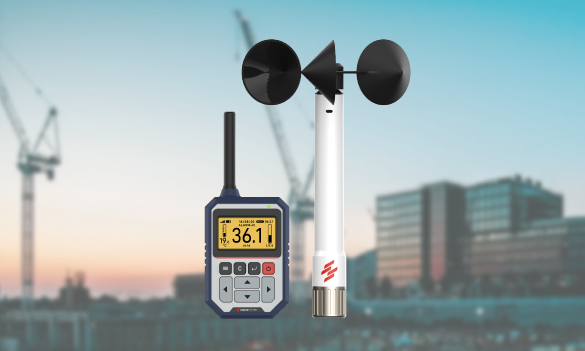
• Most Cost-Effective Wireless Anemometer
• No. 1 Sales Worldwide
• Designed for crane/lift/marine safety
• 90dB Audible Alarms
• 500-meter transmission distance
• Handheld Receiver with Large Screen
• User-Friendly Interface
• IP-67 Water-Proof Wind Sensors
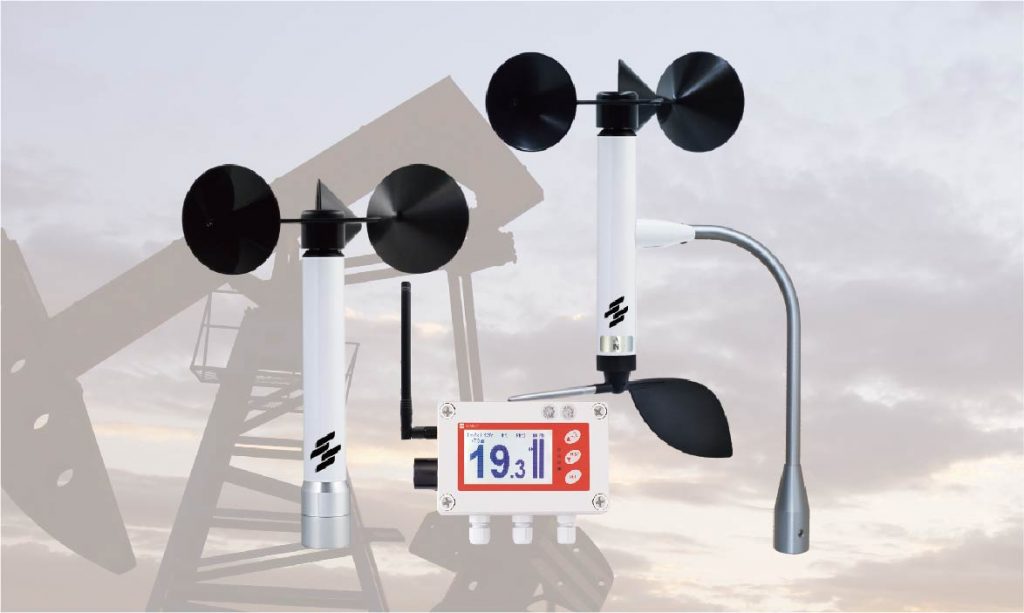
• Standalone Alarm System
• Rigorous Industrial Use
• 3 Programmable relay controls and outputs
• Instant warning at 3 different level wind speeds
• 400-meter transmission distance
• 1,300 meter or longer with external antennas
• Advanced model support smartphones and 4-20mA outputs

• Cloud-based IoT Web Portal
• Combine with Sub-1GHz wireless technology and Wifi
• Synchronize Wind Data on Receiver and Web
• Monitor Wind Anytime, Anywhere
• 24/7 Online Data Logging
• Unlimited Historical Data for Analysis
• Long transmission Range 500 meters
• First Choice Height Safety Management Tool
Scarlet Wireless Anemometers

• Most Cost-Effective Wireless Anemometer
• No. 1 Sales Worldwide
• Designed for crane/lift/marine safety
• 90dB Audible Alarms
• 500-meter transmission distance
• Handheld Receiver with Large Screen
• User-Friendly Interface
• IP-67 Water-Proof Wind Sensors
• Standalone Alarm System
• Rigorous Industrial Use
• 3 Programmable relay controls and outputs
• Instant warning at 3 different level wind speeds
• 400-meter transmission distance
• 1,300 meter or longer with external antennas
• Advanced model support smartphones and 4-20mA outputs


• Cloud-based IoT Web Portal
• Combine with Sub-1GHz wireless technology and Wifi
• Synchronize Wind Data on Receiver and Web
• Monitor Wind Anytime, Anywhere
• 24/7 Online Data Logging
• Unlimited Historical Data for Analysis
• Long transmission Range 500 meters
• First Choice Height Safety Management Tool
Heat Stress
What is Heat Stress?
Heat stress is the effect that the thermal environment has on a person’s ability to maintain a normal body temperature. Physical work generates heat in the body which must be lost to the environment through sweating and evaporation. Inability to get rid of body heat adequately may result in heat illness. Workers who are exposed to extreme heat or work in hot environments may be at risk of heat stress. Exposure to extreme heat can result in occupational illnesses and injuries. Heat stress can result in heat stroke, heat exhaustion, heat cramps, or heat rashes.
Class 1 sound level meter
What is a Class 1 Sound Level Meter?
A Class 1 Sound Level Meter is a noise measurement instrument that meets the requirements of IEC 61672-1:2002 (or an equivalent such as BS EN 61672-1:2003) to Class 1 performance. This standard specifies two levels of performance, with Class 1 being effectively more accurate. Within the standard are a set of performance criteria that an instrument must meet and each of these has a tolerance associated with it. The tolerances for Class 1 are tighter than for Class 2. For example, at the reference frequency of 1kHz, the tolerance limits for Class 1 are +/- 1.9dB and for Class 2 the tolerance is +/- 2.2dB.
Other Know Hows
Heat Stress
What is Heat Stress?
Heat stress is the effect that the thermal environment has on a person’s ability to maintain a normal body temperature. Exposure to extreme heat can result in occupational illnesses and injuries.
Class 1 sound level meter
What is a Class 1 Sound Level Meter?
A Class 1 Sound Level Meter is a noise measurement instrument that meets the requirements of IEC 61672-1:2002 (or an equivalent such as BS EN 61672-1:2003) to Class 1 performance.


